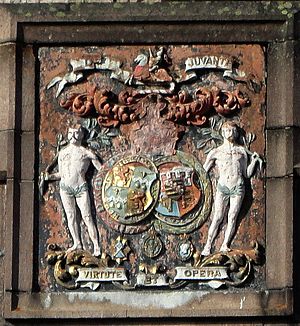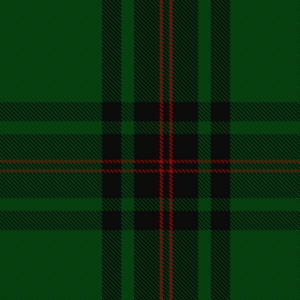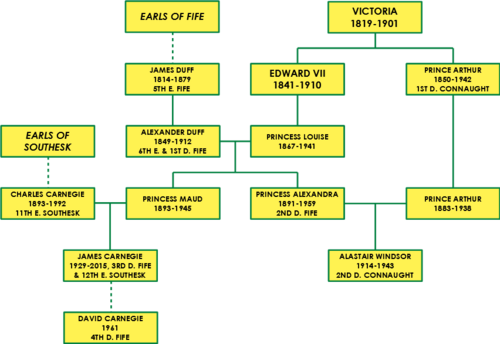Duke of Fife facts for kids
Quick facts for kids Dukedom of Fife |
|
|---|---|

Arms: Or, a Lion rampant Gules, armed and langued Azure (the Dukedom of Fife), and on an Inescutcheon Argent, ensigned of an Earl's Coronet proper, an Eagle displayed Azure, armed, beaked and membered Gules, and charged on its breast with an Antique Covered Cup Or (Carnegie). Crest: A Thunderbolt proper, winged Or. Supporters: Dexter: a Lion guardant Gules, langued Azure, collared with a Label of five-points Argent, charged with two Thistles proper, between three Crosses of St George Gules. Sinister: a Talbot Argent, collared and langued Gules. Mottoes: Above the crest, on a Scroll DRED GOD; beneath the shield DEO JUVANTE ("God helping").
|
|
| Creation date | 24 April 1900 |
| Creation | Second |
| Monarch | Queen Victoria |
| Peerage | Peerage of the United Kingdom |
| First holder | Alexander Duff, 1st Duke of Fife and 6th Earl Fife |
| Present holder | David Carnegie, 4th Duke |
| Heir apparent | Charles Carnegie, Earl of Southesk |
| Remainder to | the 1st Duke's daughters by Princess Louise and the heirs male of their bodies lawfully begotten |
| Subsidiary titles | Marquess of Macduff † Earl of Southesk Earl Fife † Earl of Fife † Earl of Macduff Viscount Macduff † Lord Carnegie of Kinnard Lord Carnegie Baron Balinhard Baron Braco † Baron Skene † Baronet 'of Pitcarrow' |
| Seat(s) | Elsick House Kinnaird Castle |
| Former seat(s) | Mar Lodge |
The Duke of Fife is a special title in the Peerage of the United Kingdom. This title has been created two times. Both times, it was given to Alexander Duff. In 1889, he married Princess Louise. She was the oldest daughter of Albert Edward, Prince of Wales, who later became King Edward VII.
The Dukedom of Fife was created for someone who married into the British royal family. This is because the first Duke's wife was a granddaughter of Queen Victoria.
Contents
History of the Dukedom of Fife
Alexander Duff (1849–1912) was the oldest son of the 5th Earl Fife. When his father passed away in 1879, Alexander became the 6th Earl Fife. He also inherited several other titles, like Baron Braco and Viscount Macduff. These titles were part of the Peerage of Ireland. He also became Baron Skene in the Peerage of the United Kingdom. This last title allowed him to have a seat in the House of Lords.
In 1885, Queen Victoria gave Alexander Duff another title: Earl of Fife in the Peerage of the United Kingdom.
On July 27, 1889, Alexander married Princess Louise. She was the third child and oldest daughter of the Prince of Wales. He later became King Edward VII. Princess Louise's mother was Princess Alexandra. Their wedding took place at Buckingham Palace. Alexander and Louise were distant cousins, both related to King George III.
This wedding was special because it was only the second time a grandchild of Queen Victoria married someone who was not a royal. Just two days after the wedding, Queen Victoria made Alexander, Lord Fife, a Marquess of Macduff and Duke of Fife. Both of these new titles were in the Peerage of the United Kingdom. The original rule for these titles was that they could only be passed down to his male children.
However, on April 24, 1900, Queen Victoria made a new rule. She created the titles of Duke of Fife and Earl of Macduff again for Alexander. This time, she added a special rule. If Alexander did not have a son, these titles could pass to his daughters by Princess Louise. Then, they could pass to the male children of those daughters.
On November 9, 1905, King Edward VII gave Alexander Duff's two daughters, Lady Alexandra (born 1891) and Lady Maud (born 1893), the special titles of Highness and Princess.
When the 1st Duke of Fife died in January 1912, most of his older titles ended. But the titles created in 1900, the Dukedom of Fife and the Earldom of Macduff, passed to his older daughter, Princess Alexandra (1891–1959).
On October 15, 1913, the 2nd Duchess of Fife married Prince Arthur of Connaught. He was the only son of Prince Arthur, Duke of Connaught and Strathearn. This made him a younger brother of her grandfather, King Edward VII. So, Arthur and Alexandra were first cousins once removed. Their only son, Alastair, passed away in 1943.
When the 2nd Duchess of Fife died in 1959, her titles went to her nephew, James Carnegie (1929–2015). He was the oldest son of her sister Maud. In 1992, the 3rd Duke of Fife also became the 12th Earl of Southesk. He also became the chief of the Clan Carnegie.
When James Carnegie died in 2015, his son, David Charles Carnegie (born 1961), became the 4th Duke of Fife. The 4th Duke of Fife's son, Charles Duff Carnegie (born 1989), is next in line for the title. He uses the special title Earl of Southesk.
Tartan of the Duke of Fife
The Duke of Fife tartan is a special pattern. It was first created to celebrate the marriage of Princess Louise to Alexander Duff, 1st Duke of Fife. Princess Louise was the daughter of King Edward VII.
Homes of the Dukes
The current Duke of Fife lives mainly at Kinnaird Castle. This castle is near the town of Brechin in Angus, Scotland. Another home is Elsick House, which is near Stonehaven in Aberdeenshire, Scotland.
Mar Lodge was the home of the 1st Duke of Fife. It is located west of Braemar in Aberdeenshire. The 2nd Duchess later gave it to her nephew, Alexander Ramsay of Mar. It was then sold. The first two Dukes of Fife are buried at St Ninian's Chapel, Braemar.
Line of Succession
This list shows who would inherit the title next:
 Alexander Duff, 1st Duke of Fife (1849-1912)
Alexander Duff, 1st Duke of Fife (1849-1912)
 Princess Alexandra, 2nd Duchess of Fife (1891-1959)
Princess Alexandra, 2nd Duchess of Fife (1891-1959)
- Alastair Windsor, 2nd Duke of Connaught and Strathearn (1914-1943)
- Maud Carnegie, Countess of Southesk (1893-1945)
 James Carnegie, 3rd Duke of Fife (1929-2015)
James Carnegie, 3rd Duke of Fife (1929-2015)
 David Carnegie, 4th Duke of Fife (b. 1961)
David Carnegie, 4th Duke of Fife (b. 1961)
'*'(1) Charles Carnegie, Earl of Southesk (b. 1989) '*'(2) Lord George Carnegie (b. 1991) '*'(3) Lord Hugh Carnegie (b. 1993)
Family Tree
| Family tree: Earls of Fife, Dukes of Fife, Earls of Southesk and Earls of Northesk | |||||||||||||||||||||||||||||||||||||||||||||||||||||||||||||||||||||||||||||||||||||||||||||||||||||||||||||||||||||||||||||||||||||||||||||||||||||||||||||||||||||||||||||||||||||||||||||||||||||||||||||||||||||||||||||||||||||||||||||||||||||||||||||||||||||||||||||||||||||||||||||||||||||||||||||||||||||||||||||||||||||||||||||||||||||||||||||||||||||||||||||||||||||||||||||||||||||||||||||||||||||||||||||||||||||||||||||||||||||||||||||||||||||||||||||||||||||||||||||||||||||||||||||||||||||||||||||||||||||||||||||||||||||||||||||||||||||||||||||||||||||||||||||||||||||||||||||||||||||||||||||||||||||||||||||||||||||||||||||||||||||||||||||||||||||||||||||||||||||||||||||||||||||||||||||||||||||||||||||||||||||||||||||||||||||||||||||||||||||||||||||||||||||||||||||||||||||||||||||||||||||||||||||||||||||||||||||||||||||||||||||||||||||||||||||||||||||||||||||||||||||||||||||||||||||||||||||||||||||||||||||||||||||||||||||||||||||||||||||||||||||||||||||||||||||||||||||||||||||||
|---|---|---|---|---|---|---|---|---|---|---|---|---|---|---|---|---|---|---|---|---|---|---|---|---|---|---|---|---|---|---|---|---|---|---|---|---|---|---|---|---|---|---|---|---|---|---|---|---|---|---|---|---|---|---|---|---|---|---|---|---|---|---|---|---|---|---|---|---|---|---|---|---|---|---|---|---|---|---|---|---|---|---|---|---|---|---|---|---|---|---|---|---|---|---|---|---|---|---|---|---|---|---|---|---|---|---|---|---|---|---|---|---|---|---|---|---|---|---|---|---|---|---|---|---|---|---|---|---|---|---|---|---|---|---|---|---|---|---|---|---|---|---|---|---|---|---|---|---|---|---|---|---|---|---|---|---|---|---|---|---|---|---|---|---|---|---|---|---|---|---|---|---|---|---|---|---|---|---|---|---|---|---|---|---|---|---|---|---|---|---|---|---|---|---|---|---|---|---|---|---|---|---|---|---|---|---|---|---|---|---|---|---|---|---|---|---|---|---|---|---|---|---|---|---|---|---|---|---|---|---|---|---|---|---|---|---|---|---|---|---|---|---|---|---|---|---|---|---|---|---|---|---|---|---|---|---|---|---|---|---|---|---|---|---|---|---|---|---|---|---|---|---|---|---|---|---|---|---|---|---|---|---|---|---|---|---|---|---|---|---|---|---|---|---|---|---|---|---|---|---|---|---|---|---|---|---|---|---|---|---|---|---|---|---|---|---|---|---|---|---|---|---|---|---|---|---|---|---|---|---|---|---|---|---|---|---|---|---|---|---|---|---|---|---|---|---|---|---|---|---|---|---|---|---|---|---|---|---|---|---|---|---|---|---|---|---|---|---|---|---|---|---|---|---|---|---|---|---|---|---|---|---|---|---|---|---|---|---|---|---|---|---|---|---|---|---|---|---|---|---|---|---|---|---|---|---|---|---|---|---|---|---|---|---|---|---|---|---|---|---|---|---|---|---|---|---|---|---|---|---|---|---|---|---|---|---|---|---|---|---|---|---|---|---|---|---|---|---|---|---|---|---|---|---|---|---|---|---|---|---|---|---|---|---|---|---|---|---|---|---|---|---|---|---|---|---|---|---|---|---|---|---|---|---|---|---|---|---|---|---|---|---|---|---|---|---|---|---|---|---|---|---|---|---|---|---|---|---|---|---|---|---|---|---|---|---|---|---|---|---|---|---|---|---|---|---|---|---|---|---|---|---|---|---|---|---|---|---|---|---|---|---|---|---|---|---|---|---|---|---|---|---|---|---|---|---|---|---|---|---|---|---|---|---|---|---|---|---|---|---|---|---|---|---|---|---|---|---|---|---|---|---|---|---|---|---|---|---|---|---|---|---|---|---|---|---|---|---|---|---|---|---|---|---|---|---|---|---|---|---|---|---|---|---|---|---|---|---|---|---|---|---|---|---|---|---|---|---|---|---|---|---|---|---|---|---|---|---|---|---|---|---|---|---|---|---|---|---|---|---|---|---|---|---|---|---|---|---|---|---|---|---|---|---|---|---|---|---|---|---|---|---|---|---|---|---|---|---|---|---|---|---|---|---|---|---|---|---|---|---|---|---|---|---|---|---|---|---|---|---|---|---|---|---|---|---|---|---|---|---|---|---|---|---|---|---|---|---|---|---|---|---|---|---|---|---|---|---|---|---|---|---|---|---|---|---|---|---|---|---|---|---|---|---|---|---|---|---|---|---|---|---|---|---|---|---|---|---|---|---|---|---|---|---|---|---|---|---|---|---|---|---|---|---|---|---|---|---|---|---|---|---|---|---|---|---|---|---|---|---|---|---|---|---|---|---|---|---|---|---|---|---|---|---|---|---|---|---|---|---|---|---|---|---|---|---|---|---|---|---|---|---|---|---|---|---|---|---|---|---|---|---|---|---|---|---|---|---|---|---|---|---|---|---|---|---|---|---|---|---|---|---|---|---|---|---|---|---|---|---|---|---|---|---|---|---|---|---|---|---|---|---|---|---|---|---|---|---|---|---|---|---|---|---|---|---|---|---|---|---|---|---|---|---|---|---|---|---|---|---|---|---|---|---|---|---|---|---|---|---|---|---|---|---|---|---|---|---|---|---|---|---|---|---|---|---|---|---|---|---|---|---|---|---|---|---|---|---|---|---|---|---|---|---|---|---|---|---|---|---|---|---|---|---|---|---|---|---|---|---|---|---|---|---|---|---|---|---|---|---|---|---|---|---|---|---|---|---|---|---|---|---|---|---|---|---|---|---|---|---|---|---|---|---|---|---|---|---|---|
|
|||||||||||||||||||||||||||||||||||||||||||||||||||||||||||||||||||||||||||||||||||||||||||||||||||||||||||||||||||||||||||||||||||||||||||||||||||||||||||||||||||||||||||||||||||||||||||||||||||||||||||||||||||||||||||||||||||||||||||||||||||||||||||||||||||||||||||||||||||||||||||||||||||||||||||||||||||||||||||||||||||||||||||||||||||||||||||||||||||||||||||||||||||||||||||||||||||||||||||||||||||||||||||||||||||||||||||||||||||||||||||||||||||||||||||||||||||||||||||||||||||||||||||||||||||||||||||||||||||||||||||||||||||||||||||||||||||||||||||||||||||||||||||||||||||||||||||||||||||||||||||||||||||||||||||||||||||||||||||||||||||||||||||||||||||||||||||||||||||||||||||||||||||||||||||||||||||||||||||||||||||||||||||||||||||||||||||||||||||||||||||||||||||||||||||||||||||||||||||||||||||||||||||||||||||||||||||||||||||||||||||||||||||||||||||||||||||||||||||||||||||||||||||||||||||||||||||||||||||||||||||||||||||||||||||||||||||||||||||||||||||||||||||||||||||||||||||||||||||||||
See also
- Duchess of Fife




